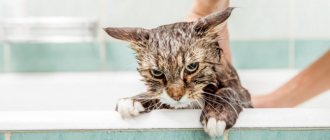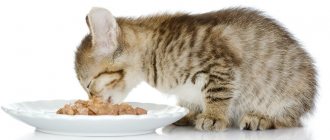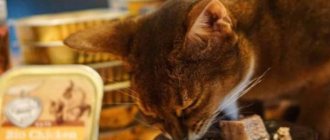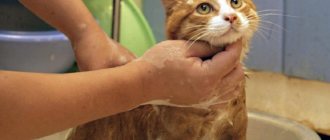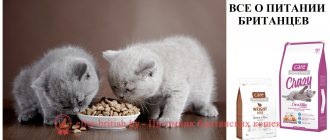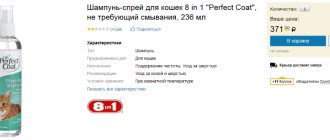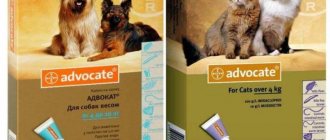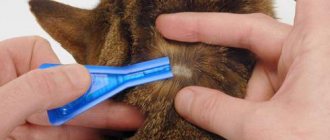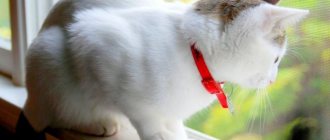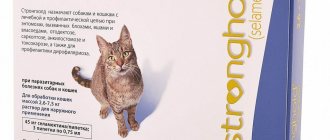Compared to other products, shampoos are allowed to be used for the weakened, pregnant, lactating, and underweight pets. Today, Russian stores offer several types of shampoos:
- Liquid. Recognized as the most convenient and popular. Veterinarians do not advise using them too often. The fact is that with frequent use, the liquid consistency damages the natural functioning of the sebaceous glands.
- Dry. The composition resembles ordinary powder that is sprinkled on a cat's fur. Ideal if it is very difficult for an animal to tolerate the usual bathing procedures, as well as when the animal needs to be bathed outside the home. After application, the composition is combed out, however, it will not be possible to clean heavy stains in this way.
- Sprays. The compositions have an antistatic effect, so they are often used for long-haired pets. It does not need to be washed off, but not all animals are able to calmly tolerate the sounds of spraying.
Due to the fact that shampoo may contain not only harmless components, but also toxic ones, veterinarians strongly advise carrying out the cleansing process strictly according to the instructions.
Some shampoos contain natural plant extracts that have a positive effect on your pet's coat and skin.
Shampoo review
Today, stores have a wide range of products, but not many have been able to prove their effectiveness. The following popular brands are considered the most famous and active:
- "Bars" . Aimed at killing not only fleas, but also ticks. The composition includes essential oils and plant extracts that care for the animal's fur and make combing easier. Just one application is enough to kill parasites. It will cost the owners 170 rubles.
- “4 with a tail . Made from insecticide poisons and vegetable oils that have a repellent effect. It is recommended to use for preventive purposes. The cost of the product does not exceed 70 rubles.
- “Lugovoy” . Domestic detergent components do a good job not only of killing parasites, but also effectively care for the animal’s fur. Improved with extracts from medicinal plants. Foams well and is easily washed off with water. The cost varies between 150 rubles per 270 ml.
- “Clandestine” is also created on the basis of various additives that care for the skin. The animal's coat acquires a healthy shine and becomes stronger. The soft composition does not irritate the mucous membranes of the eyes. Stores offer to purchase “Clandestine” for 70 rubles.
- “Phytoelite” . Manufacturers used enteric-contact toxic substances that have a nerve-paralytic effect. For the best effect, the drug should be on the cat’s skin and fur for at least 5 minutes. The average price of the product is about 330 rubles.
- " Beaphar" The composition is enriched with essential oils of mangose, lavender and citronella. Used as an ordinary shampoo, with an exposure time of 5 minutes on the animal's fur. One bottle contains 250 ml of the substance. The cost is quite high, about 470 rubles.
- "Dana" . The drug was manufactured in laboratory conditions by the efforts of domestic veterinarians. Within 24 hours it acts on parasites and removes unpleasant odors. Dana is produced separately for adult cats and small kittens. The duration of action of the product is 10 days. The price does not exceed 100 rubles.
- “Ms. Kiss.” The ingredients provide high-quality protection against fleas, lice and lice. The efforts of Swiss manufacturers were aimed at the destruction of parasites and high-quality hair care. After using it, the wool becomes softer and has a pronounced shine. The main active ingredient is 0.5% permethrin. For 4 kg of weight, no more than 1 ml is used. facilities. For convenience, the bottle is equipped with a special dispenser. Cost Ms. Kiss is presented within 200 rubles.
- "Rolf Club " The action has the same qualities as Ms. Kiss. Well suited for long-haired cats. Its cost does not exceed 250 rubles.
- - GROOM" It is recognized as a highly effective means of combating parasites, but its cost is quite high. It will cost the owners at least 1000 rubles. It not only rids the animal of fleas, but also prevents their subsequent appearance. The protein lanolin is released. This promotes not only high-quality cleansing, but also easy combing, provides a pleasant aroma, and prevents dryness in advance.
Review of the best drugs
Flea shampoos for kittens and cats
Before purchasing, it is advisable to familiarize yourself with the reviews of the flea shampoo for cats. The opinions of users who have already tested the drug will help make a more accurate choice.
Mr Kiss
According to most users, the best shampoo of all presented. It is developed by a Swiss company and the main component is permethrin. The drug instantly kills existing ectoparasites.
On a note!
The product for long-haired individuals contains a special component that is designed to facilitate combing and prevent the hair from tangling.
You can choose a product depending on the color of your pet’s coat. The average cost is about 170-250 rubles.
Review
Mr Kiss shampoo helped us remove fleas from our cat. Now we use it on a regular basis. The light aroma does not irritate the cat and therefore bathing is easy and without hysterics. We do not risk using drops due to higher toxicity.
Arina, Moscow
Biovax
A domestic flea remedy for cats, which is based on a natural insecticide from wormwood. Inexpensive components and the absence of import taxes made it the most accessible. The average cost for 350 ml is 100-125 rubles. Availability does not affect quality and the shampoo effectively fights fleas and other parasites.
Review
Biovax was recommended by the doctor. The cat is a domestic cat, but since we live in a private house, we occasionally carry out preventive measures using this product. We are pleased with the result.
Anna Anatolyevna, Ryazan
Review of shampoos for kittens
- "Kuddly Kitty " Specially designed for kittens. Created on the basis of natural ingredients that moisturize the kitten's skin without leaving irritation, does not contain soap substances. The price of shampoo is 1080 rubles.
- Ms. Kiss “Fluffy Ponytail”. Veterinarians recommend it to those whose pets have been confirmed to have allergic reactions. Its hypoallergenic composition gently envelops the hairs, caring for the coat, relieves itching and stops flaking. The price of the product does not exceed 200 rubles.
- “Phytoelite” . Contains a repellent that paralyzes insects, but has no effect against eggs. Manufacturers produce 2 types of shampoo, namely those based on natural substances, the second using chemicals. The latter are considered the most effective, but may not have the best effect on the kitten’s health. Veterinarians recommend combining them with other antiparasitic compounds. It is preferable to use shampoo made from natural ingredients.
How often to wash
For most breeds, 1-2 baths per year will be sufficient. The frequency of the procedure depends on the type and length of the coat, as well as the condition of the skin. There is a concept called “animal fur”. This means that the hair has a structure similar to that of a wolf or wild dog. These are usually large dogs with hard, thick hair.
Decorative breeds cannot boast of durable and strong hair. Their thin coat often gets dirty and requires careful care. For example, a Yorkshire Terrier needs to be washed every 7-10 days. For medium and large breeds, it is enough to wash 1-4 times a year.
Domestic dogs rarely get dirty enough to need to be washed. Usually, wiping the paws and belly with a damp towel or napkin is enough.
If your pet is very dirty or it’s time for a scheduled bath, you need to carry out the procedure correctly. It is better to wash dogs in the bathroom, in warm water. Typically, cosmetics for hair care are in the form of a concentrate, so the shampoo is first diluted in water and the pet is washed with the resulting foam. The shampoo is applied to a damp body. After this, the owner should soap the dog well, starting from the back and sides
Particular attention is paid to intimate places. To protect the ears, you will have to plug them with cotton balls or put a bathing cap on your pet.
After the shampoo has been thoroughly rinsed, apply conditioner or conditioner. It is washed off after a few minutes.
Dog wash products must be chosen very carefully. They must be appropriate for age, breed and coat type. If you wash your pet with human shampoo or soap, you can damage the fur and skin.
General rules of application
- Any drug is first diluted in water before use. This rule must always be observed, regardless of whether it is dry or liquid. If this rule is neglected, the strong concentration of the composition will not allow the animal’s fur to be thoroughly washed, which will cause him a lot of inconvenience.
- Afterwards, the mixture is applied to the animal’s fur and left for the duration of exposure. Depending on the manufacturer, the period may vary, but most often it does not exceed 5 minutes. During this time, you should carefully monitor the animal and hold it tightly enough. If the cat manages to escape, it may begin to lick itself, which is highly undesirable. This may cause the pet's health to deteriorate.
- At the third stage, the cat's fur is thoroughly washed with water;
- The animal's fur is dried and combed.
How to use flea shampoo correctly?
- When choosing a detergent in a store, pay attention, first of all, to the packaging . You should be interested in the container itself and the quality of the label. Yes, there is a high probability of counterfeits, or you will be offered to buy a shampoo that is not so expensive, but produced under dubious conditions.
- See where, when and by whom the shampoo was made . Pay attention to the expiration date.
- Read the instructions on the back of the bottle . If you don’t understand something, contact your consultant immediately, perhaps his tips will be very useful for you.
Important! Flea shampoos have varying degrees of activity. Therefore, if you need to use it on a kitten, a pregnant cat or a nursing animal, keep this in mind. And choose a product created specifically for such cases.
To carry out the procedure correctly, you must adhere to certain actions. Prepare everything you need in advance. If the cat can be washed in the bath, then a small basin with warm water will be better for the kitten. Not all cats love water, and a kitten in a large, unfamiliar space can experience extreme stress.
Sequence of actions and how to wash a cat with flea shampoo?
First you need to adjust the water, it should not be very hot, but not too cold. This is about the temperature you choose for yourself when you take a shower.
You will need to act calmly so as not to unnerve the animal again. Wet the fur thoroughly, but under no circumstances allow it to get into the ears or eyes. Simply wipe the cat's face with a wet hand.
Squeeze the shampoo onto your hand, rub it a little between your palms and distribute it with smooth movements over the fur. Carefully, but without vigorous movements, foam the detergent. Usually, the instructions for the product indicate the time for which the shampoo should be left on the animal’s fur.
Again, be careful not to get the foam in your cat's eyes or mouth.
The procedure is completed by rinsing the wool. Rinse off the shampoo thoroughly and wipe the face again with a wet hand. Squeeze the fur a little with stroking, pressing movements and wrap the cat in a towel. Often inexperienced breeders are interested in how often to wash a cat with flea shampoo. The answer can be obtained either by consulting a veterinarian or by carefully reading the instructions for the detergent.
After 2 days, carefully examine the cat’s fur and skin after washing.
You should be interested in three things:
- Are there any allergies?
- Are there live fleas?
- Quality of washing.
Based on these indicators, you can make your own decision. You may need to re-treat the animal against fleas or, in general, change the shampoo if an allergic reaction is detected in the cat.
Although specialized flea shampoos for kittens and cats are made in safe concentrations of insecticides, allergies are still possible.
Advantages and disadvantages of using flea shampoos
Advantages:
- Specially developed detergent compositions help eliminate not only unpleasant odors, but also make the cat’s fur shiny.
- A special line of products cures parasites and various other diseases.
- Clinical studies have proven that they are the safest and most effective in combating parasites. Moreover, they are safe for both adult cats and very small kittens.
- Natural shampoos do not irritate the mucous membranes , do not cause allergic reactions, and prevent the subsequent appearance of insects.
Disadvantages of shampoos. Unfortunately, the stated promises do not always correspond to the internal content. That is why doctors note a number of disadvantages:
- Most cheap products consist of 80% water, a special thickener, fragrance and soap;
- Some shampoos fail to do their job;
- High-quality shampoos are quite expensive.
How to wash a kitten if there is no special shampoo?
If there is no special shampoo, you can wash (if absolutely necessary) the cat with just water. It will perfectly wash away dirt without causing damage to the skin. Shampoos are also not suitable for other types of animals.
So, how often can you wash your kitten with shampoo? The less often you need to wash your pet, the better. Under any circumstances, this procedure can be repeated no more than once every 3-4 months, the best option is 2 times a year (as needed).
If we are talking about therapeutic bathing (for dermatitis, allergies, lichen), things are different: you need to wash the kitten as many times as the doctor prescribes.
Also an exception are exhibition animals - they are bathed immediately before the exhibition.
If you plan to take the animal to exhibitions, you need to accustom the kitten to water in advance so that in the future it experiences less stress. Some advise starting as early as a month, but it’s better to wait until two or three.
It is important to remember the following nuances:
- You cannot bathe a kitten for several days after vaccination. The British are bathed differently (like bathing a British kitten).
- 3 days before and 3 days after treatment for fleas (how to wash a kitten for fleas) and other parasites, you should also not bathe.
- It is best to wash a kitten when it adapts to its new place of residence - this is approximately 2-3 weeks.
The sequence of actions when bathing is as follows:
It is important to comb the animal before bathing if it has long hair. Wet tangles cannot be untangled and can only be gotten rid of by cutting them off.
If your kitten gets stressed while brushing, give him time to calm down before putting him in a bowl of water. You should not bathe the kitten immediately after eating - you need to wait 2-3 hours. You should fill the bath with warm water. If it is a kitten, a basin will be enough. The water should be slightly warmer than body temperature.
The kitten will feel more confident if you put a towel on the bottom - the paws will not slide as much. The entire bathing procedure should take no more than 15 minutes. If the kitten is acting very restless, you can try to divert his attention to his toys: balls, rattles, mice. You should wash the kitten carefully so that the shampoo does not get into the ears, eyes, or nose. You should also be careful with water - if it gets into your ears, it can cause an inflammatory process (otitis media). To protect them, you can use cotton balls by simply pressing them lightly into your ears. You can also make something like a shower cap out of cellophane. If this makes the kitten panic more, you should do without them and just carefully monitor the ears. After the shampoo has been thoroughly rinsed, the kitten should be wrapped in a towel and kept warm until it dries. It is advisable to comb the kitten if it has long hair. Treat the kitten to something tasty to smooth out the impressions of the “torture” and develop pleasant associations in it.
Excessive dirt in the ears may indicate problems with the ears, including a parasitic disease - otodectosis. This disease is caused by a microscopic mite and is often found in outdoor kittens. The diagnosis is confirmed by microscopy of earwax.
If a tick is detected there, appropriate treatment is prescribed, and the doctor will show and tell you how and with what to properly clean the cat’s ears, as well as what to treat. Once the kitten gets rid of the tick, regular cleaning can be stopped.
To avoid lacerations on your hands, you can trim your nails first. It is advisable to not perform this procedure right before bathing, as cats become very panicky during nail trimming.
If the panic from bathing is superimposed on the panic from trimming nails, we will not get anything good.
If the kitten is shivering for a very long time and it is clear that he is cold, you can dry him with a hairdryer (especially if the apartment is cold), but use only the cold air mode.
These simple nuances will make bathing safe for the kitten.
Efficiency and operating principle
Analogues of pyrethrins have a destructive effect on the chitinous shell of insects. Modern manufacturers try to use 2nd and 3rd generation pyrethroids.
You should know that the active ingredients destroy bees and fish. This must be taken into account if the owners have an aquarium with fish or a bee apiary.
The principle of action of the foam composition against annoying insects, as well as ticks, is simple and effective:
- When the product hits an insect , it envelops the parasite on all sides with toxic foam;
- The pyrethroids contained in the composition destroy the cocoon of the pupa , chitin of the shell and more adult insects and penetrates into the insect itself;
- After entering the body of a pest , the toxin gradually paralyzes it, depriving it of the strength to move, breathe and drink blood;
- Complete death occurs on the second day after using the shampoo. At this time, not only adult individuals are destroyed, but also their larvae, eggs and pupae. In other words, everything that was in the cat’s fur at the time of bathing is destroyed, leaving no trace behind.
How often to wash
There are a wide variety of, and sometimes conflicting, recommendations on how to wash a cat and how often it should be done. Some experienced owners advise bathing their animals once a month. Others believe that this is too frequent and advise resorting to water procedures no more than twice a year. In this matter, much depends on the breed of the pet, the condition of its coat and the health of the animal.
If the cat has luxurious long hair, then you can bathe the beauty once a month. An animal of a long-haired breed will not be able to cope with maintaining the coat in proper form on its own. If the cat has short hair, then it is advisable to carry out water procedures once every 2 months.
Owners of so-called hairless breeds are interested in how to wash their cat. Cat breeds such as Sphynx, Rex, Bambino need bathing even less often than their long-haired counterparts - once every 3 months.
Cases when a cat must be washed:
participation in exhibition events;
when the animal is dirty, especially if it is stained with paint, chemicals, building materials, etc.;
in case of severe shedding in order to prevent the development of hair balls in the animal’s stomach.
The owner should understand that in addition to dust and dirt particles, microbes also accumulate on the wool. Therefore, the animal should be washed regularly, and not occasionally.
We recommend reading about how to train a cat to use a scratching post. You will learn about the types of scratching posts, how to choose the best option for your pet, and how to make the device yourself. And here is more information about why cats have bad breath.
Shampoo selection criteria
To choose the most effective and safe remedy, you should pay attention to several main points:
- First you need to decide whether the shampoo will be used for preventive purposes, or to eliminate an existing problem;
- You should pay attention to the age of the pet, possible individual intolerances and its state of health;
- If it is possible to identify areas of mass accumulation of parasites, the product should be used in combination with other drops, sprays, etc.
- Before use, be sure to read the instructions. This way you can choose the right dosage so as not to harm your cat’s health.
How to choose a flea treatment for your cat
A pet requires increased attention and self-care, since it cannot choose protective equipment on its own. In order for the choice of drug to be useful and rational, you need to know the criteria that you should pay attention to when choosing a flea shampoo. When choosing a shampoo you should consider:
- Functional features;
- Age restrictions;
- Compatible with coat length;
- Bottle volume;
- Compound;
- Availability of additional functions;
- Efficiency of the product;
- Recommendations from veterinarians;
- Price;
- Reviews from other cat owners.
DIY flea shampoo
Despite the fact that many industrial products have proven their effectiveness, this does not mean that their chemical composition cannot cause side effects. Moreover, the composition of some is easy to prepare at home.
To make your own shampoo, you need to do the following:
- Bring 500 ml of filtered or distilled water to a boil;
- add 1.5 tbsp. crushed roots of the garden plant saponaria;
- the resulting mixture must be boiled for 20 minutes, then allowed to cool at room temperature;
- if desired, you can add 20 drops of lavender, cedar, mint, rosemary or citrus;
- the finished composition is stored in the refrigerator for no more than 14 days.
Reviews
- Svetlana Vasilyeva, 38 years old, Sochi: “I recently picked up a kitten on the street. I was horrified - it was not a kitten, but a complete collection of insects. Without exaggeration! His skin and fur were literally moving. A salesperson at a pet store recommended “Clandestine” to me. Helped a lot!”
- Anna Shipilova, 27 years old, Saratov: “In my grandmother’s village, all the cats have fleas. I bought “Dana” for washing. It is inexpensive, the smell is pleasant, it can be used both against fleas and just for washing. The fleas are out. Now grandma washes them every 2 months using shampoo. Fleas don’t have time to get started”
- Sergey Avdeev, 35 years old, Chekhov: “The shampoo just didn’t help us. The fleas disappeared only after complex use. We combined the detergent composition with Advantix flea drops. The procedure had to be repeated 2 times. I'm happy with the result."
- Alena Mirgorodskaya, 22 years old, Yekaterinburg: “My domestic cats also grabbed these insects somewhere. I figured it out like this: first of all, I washed them with shampoo and put on a collar. Plus, I washed the floors and furniture in the apartment with this same shampoo, but only with diluted shampoo. It helped. By the way, I used “Apit”.
- Elena Oleynikova, 33 years old, Perm: “I use shampoo from the Bio series. It is completely natural and absolutely safe. Kills not only fleas, but also ticks. I bathe my cat with it at least 2 times a season. During this time, insects simply do not have time to appear.”
Effect of shampoo
Flea shampoo is an effective effective drug that has a number of positive effects due to its composition:
- It has selective toxicity: aggressive effect on fleas, no effect on warm-blooded animals.
- Ability to remain on the skin and fur for a long time.
- Contact action of active substances, the ability to quickly penetrate the cuticle and protective shell of the flea.
- High efficiency at low to moderate temperatures.
- Therapeutic and prophylactic preparations of 2-3 generations of insecticides: stability when exposed to high humidity and active sunlight, low toxicity.
- Providing a paralyzing effect not only on the adult flea, but also on the larvae and eggs.
- The presence of methionine (alpha amino acid) in the composition helps to increase the strength and elasticity of wool and stimulate its growth.
- Hygienic and medicinal products are enriched with microelements that strengthen cat hair.
- The presence of lavender and citrus essential oil enhances the insecticidal properties of the active substances.
- The presence of coltsfoot, burdock, celandine, and plantain helps eliminate irritation, itching of the skin, and rapid skin regeneration.
The question of how flea shampoo works can only be answered after studying the active ingredients. The flea shampoo contains active ingredients with selective, lipophilic properties.
When using the product, it is important to pay attention to restrictions according to the age of the animal.
